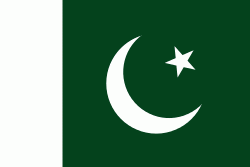Charsadda District (Chārsadda District)
Charsadda District (چارسدہ ولسوالۍ, ) is a district in Peshawar Division of Khyber Pakhtunkhwa province in Pakistan. Prior to its establishment as a separate district in 1998, it was a tehsil within Peshawar District. Pashtuns make up majority of the population of the district. District headquarter is town of Charsadda, which was part of the Peshawar ex-metropolitan region.
The district lies between 34-03' and 34-38' north latitudes and 71-28' and 71-53' east longitudes. Charsadda is located in the west of the Khyber Pakhtunkhwa and is bounded by Malakand District to the north, Mardan district to the east, Nowshera and Peshawar districts to the south and Mohmand district to the west. The district covers an area of 996 square kilometers.
Charsadda was once part of the kingdom of Gandhara, however around 516 BC Gandhara became part of the seventh satrapy or province of the Achaemenid Empire and paid tribute to Darius the Great of Persia, until its overthrow by Alexander the Great in the 4th century BC.
After the death of Alexander in 323 BC the Indian Emperor Chandragupta Maurya rose to power and brought Gandhara under his sway. According to a popular tradition, Emperor Ashoka built one of his stupas there. This stupa was mentioned by the famous Chinese Buddhist pilgrim Hieun Tsang, who visited in 630, according to him Po-Lu-Sha (as he called the stupa) was 2.5 mi in circumference.
A Brahminical temple to the east and a monastery to the north which according to Buddhist legends was the place where Buddha preached the Law. The name Gandhara disappeared after Mahmud of Ghazni conquered the area and converted it to Islam in 1026.
The district lies between 34-03' and 34-38' north latitudes and 71-28' and 71-53' east longitudes. Charsadda is located in the west of the Khyber Pakhtunkhwa and is bounded by Malakand District to the north, Mardan district to the east, Nowshera and Peshawar districts to the south and Mohmand district to the west. The district covers an area of 996 square kilometers.
Charsadda was once part of the kingdom of Gandhara, however around 516 BC Gandhara became part of the seventh satrapy or province of the Achaemenid Empire and paid tribute to Darius the Great of Persia, until its overthrow by Alexander the Great in the 4th century BC.
After the death of Alexander in 323 BC the Indian Emperor Chandragupta Maurya rose to power and brought Gandhara under his sway. According to a popular tradition, Emperor Ashoka built one of his stupas there. This stupa was mentioned by the famous Chinese Buddhist pilgrim Hieun Tsang, who visited in 630, according to him Po-Lu-Sha (as he called the stupa) was 2.5 mi in circumference.
A Brahminical temple to the east and a monastery to the north which according to Buddhist legends was the place where Buddha preached the Law. The name Gandhara disappeared after Mahmud of Ghazni conquered the area and converted it to Islam in 1026.
Map - Charsadda District (Chārsadda District)
Map
Country - Pakistan
 |
 |
| Flag of Pakistan | |
Pakistan is the site of several ancient cultures, including the 8,500-year-old Neolithic site of Mehrgarh in Balochistan, the Indus Valley civilisation of the Bronze Age, the most extensive of the civilisations of the Afro-Eurasia, and the ancient Gandhara civilization. The region that comprises the modern state of Pakistan was the realm of multiple empires and dynasties, including the Achaemenid; briefly that of Alexander the Great; the Seleucid, the Maurya, the Kushan, the Gupta; the Umayyad Caliphate in its southern regions, the Hindu Shahis, the Ghaznavids, the Delhi Sultanate, the Mughals, the Durranis, the Omani Empire, the Sikh Empire, British East India Company rule, and most recently, the British Indian Empire from 1858 to 1947.
Currency / Language
| ISO | Currency | Symbol | Significant figures |
|---|---|---|---|
| PKR | Pakistani rupee | ₨ | 2 |
| ISO | Language |
|---|---|
| EN | English language |
| PA | Panjabi language |
| PS | Pashto language |
| SD | Sindhi language |
| UR | Urdu |















